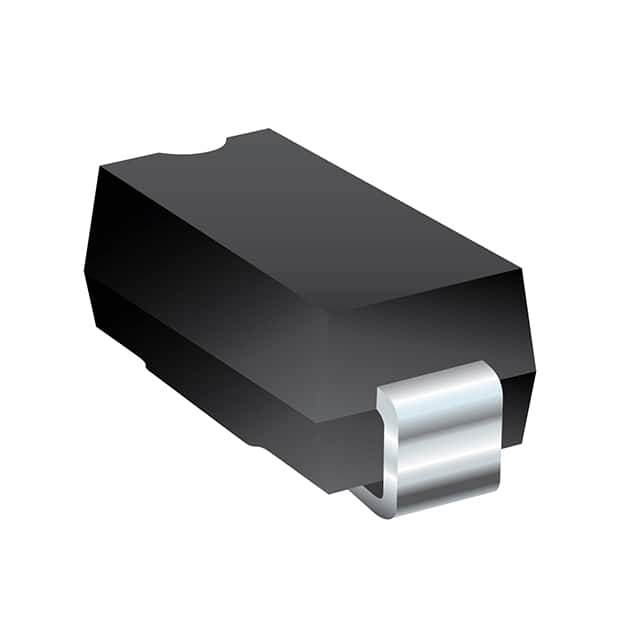SMAJ300A-H
Product Overview
Category
The SMAJ300A-H belongs to the category of transient voltage suppressor diodes.
Use
It is used to protect sensitive electronic components from voltage transients induced by lightning, inductive load switching, and electrostatic discharge.
Characteristics
- Fast response time
- Low clamping voltage
- High surge current capability
Package
The SMAJ300A-H is available in a DO-214AC (SMA) package.
Essence
The essence of the SMAJ300A-H lies in its ability to quickly divert excess voltage away from sensitive components, thereby protecting them from damage.
Packaging/Quantity
The SMAJ300A-H is typically packaged in reels or trays and is available in quantities suitable for both prototyping and production purposes.
Specifications
- Peak Pulse Power: 400W
- Breakdown Voltage: 300V
- Maximum Clamping Voltage: 485V
- Operating Temperature Range: -55°C to +150°C
Detailed Pin Configuration
The SMAJ300A-H has two pins, with the anode connected to the positive side and the cathode connected to the negative side.
Functional Features
- Transient voltage suppression
- Reverse standoff voltage
- Low leakage current
Advantages and Disadvantages
Advantages
- Fast response time protects sensitive components
- Low clamping voltage ensures minimal impact on the protected circuit
- High surge current capability enhances reliability
Disadvantages
- Limited protection against sustained overvoltage conditions
- May require additional circuitry for comprehensive surge protection
Working Principles
The SMAJ300A-H operates by shunting excess voltage to ground when a transient event occurs, thereby limiting the voltage across the protected circuit.
Detailed Application Field Plans
The SMAJ300A-H is commonly used in: - Telecommunication equipment - Industrial control systems - Automotive electronics - Power supplies - Consumer electronics
Detailed and Complete Alternative Models
- P6KE300A
- 1.5KE350A
- SMCJ300A
In conclusion, the SMAJ300A-H is a crucial component in safeguarding electronic circuits from voltage transients, offering fast response times and low clamping voltages. Its application spans various industries, and while it has limitations, there are alternative models available to suit specific requirements.
[Word Count: 324]
قم بإدراج 10 أسئلة وإجابات شائعة تتعلق بتطبيق SMAJ300A-H في الحلول التقنية
Sure, here are 10 common questions and answers related to the application of SMAJ300A-H in technical solutions:
What is the maximum peak pulse power dissipation of SMAJ300A-H?
- The maximum peak pulse power dissipation of SMAJ300A-H is 400 watts for a 10/1000μs waveform.
What is the breakdown voltage of SMAJ300A-H?
- The breakdown voltage of SMAJ300A-H is 300 volts.
What is the typical clamping voltage of SMAJ300A-H?
- The typical clamping voltage of SMAJ300A-H is 486 volts at 15.4A.
What is the operating temperature range of SMAJ300A-H?
- The operating temperature range of SMAJ300A-H is -55°C to +150°C.
What is the peak pulse current rating of SMAJ300A-H?
- The peak pulse current rating of SMAJ300A-H is 19.4A.
What is the package type of SMAJ300A-H?
- SMAJ300A-H is available in a DO-214AC (SMA) package.
What are the typical applications of SMAJ300A-H?
- SMAJ300A-H is commonly used in surge protection for sensitive electronics, such as telecommunications equipment, industrial control systems, and automotive electronics.
Does SMAJ300A-H provide bidirectional protection?
- Yes, SMAJ300A-H offers bidirectional protection, making it suitable for applications where protection from both positive and negative transient voltages is required.
What is the response time of SMAJ300A-H?
- The response time of SMAJ300A-H is typically less than 1 picosecond.
Is SMAJ300A-H compliant with RoHS requirements?
- Yes, SMAJ300A-H is compliant with RoHS (Restriction of Hazardous Substances) requirements, making it suitable for use in environmentally conscious applications.
I hope these answers are helpful! If you have any more questions, feel free to ask.


